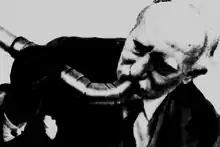Frederick Tansley Munnings
Frederick Tansley Munnings (1875, Lowestoft – 1953)[1] was a 20th-century British spiritualist medium and former burglar. He was exposed as a fraud.[2]

Career
Munnings lived in Hastings and worked as a boarding-house keeper. He was convicted of burglary for housebreaking at Woking and was sentenced to nine months' imprisonment.[1][3] Munnings claimed to be a "direct voice" medium, but was exposed as a fraud when one of his séance sitters turned the lights on, revealing him to be holding a trumpet by means of a telescopic extension piece and using an angle piece to change the auditory effect of his voice.[4]
In February 1926 a public warning against Munnings was issued in the press by Arthur Conan Doyle, Abraham Wallace, R. H. Saunders, and H. D. Bradley.[5] The psychical researcher Harry Price also exposed his fraudulent mediumship. Munnings claimed to produce the independent "spirit" voices of Julius Caesar, Dan Leno, Hawley Harvey Crippen and King Henry VIII. Price invented and used a piece of apparatus known as a voice control recorder and proved that all the voices were those of Munnings. Munnings admitted fraud and sold his confessions to a Sunday newspaper.[6]
Munnings's daughter Hilda Tansley Munnings became a noted ballerina under the name Lydia Sokolova.
References
- "A Varied Career." South Australian Register, March 15, 1923, p. 12.
- Tabori, Paul. (1966). Harry Price: The Biography of a Ghosthunter. Living Books. p. 125
- Justice of the Peace. (1923). Volume 87. Henry Shaw. p. 8
- Franklyn, Julian. (2003). A Survey of the Occult. pp. 238-239. Kessinger Publishing. ISBN 978-0766130074
- Frederick Tansley Munnings
- Price, Harry. (1939). Chapter The Mechanics of Spiritualism in Fifty Years of Psychical Research. Kessinger Publishing. ISBN 978-0766142428
External links
- 'Astonishing Confessions of a "Bogus Spirit" Medium' Munnings's confession published in the Milwaukee Sentinel, July 28, 1928
- Anonymous. (1925). The Cases of Mr. Moss and Mr. Munnings Journal of the Society for Psychical Research 22: 71–75.